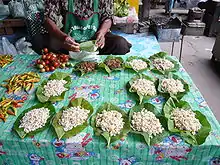Ant eggs
Ant eggs (Thai: ไข่มดเเดง, RTGS: khai mot daeng) refer to both the eggs and pupae of weaver ants (known in Thailand as red ants), that are harvested and consumed as food in several countries across Southeast Asia, especially Laos and Northeastern Thailand (Isan). They are high in protein. Red ants eat mango leaves so their bodies taste like a squirt of lime, but their fresh eggs are fatty and sweet.[1]

Nutrition
Ant eggs are a high source of protein. 100 grams contains more than 8.2 grams of protein. It has less fat and calories than chicken eggs by containing only 2.6 grams of fat while chicken egg contains more than 11.7 grams.[2] It contains other minerals such as; calcium, phosphorus, iron, sodium, potassium, vitamin B1, vitamin B2 and Niacin.[3]
Uses
Red ant eggs are cooked in types of food such as Spicy Raw Ant Egg Salad. ก้อยไข่มดเเดง seems to be the most popular dish. Because they contain acetic acid, red ant eggs are used instead of lemon juice or vinegar in many Thai dishes.
They can be used to exterminate pests such as insect larvae and aphids, because they are the ants' food.[1]
Farming
Farmers cultivate the popular eggs. Five factors affect growth rates.[4]
Settlement
Ants like to live in an open ground area with many trees but not dense shade. From October to December ants quickly build a large nest. The bigger the nest, the more eggs it can store.[4]
Trees
Ants build their colonies on various kind of trees, but they prefer mango, rambutan, longan, litchi, apple and orange.[4]
Close observation
Ants from different colonies fight and can destroy some colonies if not adequately separated.[4]
Feeding
Ants prefer raw food over cooked or dried and they like small, weak, or dying but not rotten animals. Their food should be small enough that they can carry it into the colony. Food needs are greatest during the early spawning season from September to December and during the spawning season from January to April. After the eggs have been collected during May to June, the ants need to be fed frequently and in large quantities.[4]
After collection
After the eggs are collected the colony will weaken, leaving it vulnerable to nearby colonies.[4]
References
- "ประโยชน์ของไข่มดแดง". clipmass.com.
- https://web.archive.org/web/20141129095755/http://health.kapook.com/view82796.htm. Archived from the original on November 29, 2014. Retrieved November 23, 2014. Missing or empty
|title=(help) - "ไข่มดแดง". gotoknow.org.
- "The Making Red Ant Farm for Commerce". ku.ac.th. Archived from the original on 2015-08-24. Retrieved 2014-11-23.
